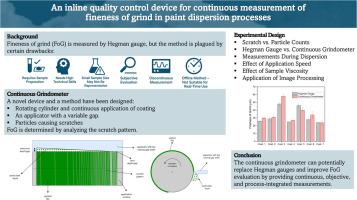一种用于油漆分散过程中研磨细度连续测量的在线质量控制装置
IF 3.9
3区 工程技术
Q3 ENERGY & FUELS
Chemical Engineering and Processing - Process Intensification
Pub Date : 2025-09-18
DOI:10.1016/j.cep.2025.110561
引用次数: 0
摘要
本研究研究了一种新开发的新型连续研磨仪的性能和适用性,该研磨仪旨在通过颜料分散过程中颗粒产生的划痕来监测研磨的细度。该设备提供连续、实时测量,旨在解决传统Hegman仪表的局限性,如操作员依赖性和有限的采样。使用各种商业涂层的对比试验表明,连续磨削计可以产生与Hegman计相当的结果。在不同颜料的分散过程中对其性能进行了进一步评估,确认了该设备跟踪细度随时间变化的能力。还考察了涂胶速度和流变性能的影响。结果表明,划痕可见性取决于涂布器的转速和样品的粘度。在至少10 cm/s的应用速度和500-50,000 cP范围内的低剪切粘度下,实现了最佳性能。总体而言,连续研磨仪被证明是传统方法的一个有前途的替代方案,提供了过程中质量监控,增加了采样量,提高了测量客观性。本文章由计算机程序翻译,如有差异,请以英文原文为准。

An inline quality control device for continuous measurement of fineness of grind in paint dispersion processes
This study investigates the performance and applicability of a newly developed, novel continuous grindometer designed to monitor the fineness of grind via scratches made by particles during pigment dispersion processes. The device offers continuous, real-time measurement and aims to address limitations of the traditional Hegman gauge, such as operator dependency and limited sampling. Comparative tests using various commercial coatings demonstrated that the continuous grindometer can produce results comparable to those of the Hegman gauge. Its performance was further evaluated during the dispersion of different pigments, confirming the device's ability to track changes in fineness over time. The effects of application speed and rheological behavior were also examined. Results showed that scratch visibility depends on both the rotational speed of the applicator and the viscosity of the sample. Optimal performance was achieved with an application speed of at least 10 cm/s and low-shear viscosities in the range of 500–50,000 cP. Overall, the continuous grindometer proved to be a promising alternative to traditional methods, offering in-process quality monitoring, increased sampling volume, and greater measurement objectivity.
求助全文
通过发布文献求助,成功后即可免费获取论文全文。
去求助
来源期刊
CiteScore
7.80
自引率
9.30%
发文量
408
审稿时长
49 days
期刊介绍:
Chemical Engineering and Processing: Process Intensification is intended for practicing researchers in industry and academia, working in the field of Process Engineering and related to the subject of Process Intensification.Articles published in the Journal demonstrate how novel discoveries, developments and theories in the field of Process Engineering and in particular Process Intensification may be used for analysis and design of innovative equipment and processing methods with substantially improved sustainability, efficiency and environmental performance.

 求助内容:
求助内容: 应助结果提醒方式:
应助结果提醒方式:


